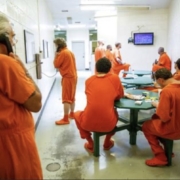Analyzing legislators’ recent attempts to address the FBOP Crisis
Although correctional facilities and practices in the United States may not be as bad as those which exist in lessor developed countries, American prison systems have routinely been criticized for having a substantial amount of correctional officer deviance, corruption, poor living conditions, including overcrowding, substandard food, medical and psychiatric care, among other challenges. Some experts have even suggested that these elements are examples of human rights violations.
More recently, in February 2022, Senators John Ossoff (Dem-Georgia) and Mike Braun (Rep- Indiana), spearheaded a 10-month investigation into corruption, abuse, and misconduct at United States Penitentiary Atlanta (USPA) and within the Federal Bureau of Prisons (FBOP).
In order to put things in context, it’s important to understand that several correctional systems operate in the United States. We find them at the local, state, and federal level. But the FBOP, is the prison system that is responsible for managing 122 correctional facilities and according to most recent statistics (June 1, 2023) incarcerates about 159,116 people. Among the numerous correctional facilities in the FBOP there are both prisons specifically designed for men and those for women.
Ossoff and Braun’s investigation was formed under the auspices of “The Senate Bipartisan Prison Policy Working Group” that was established to “identify and advance solutions.”
The working group included four hearings:
• The July 2022 hearing on corruption, abuse and misconduct at the BOP’s Atlanta prison revealed “a facility where inmates, including presumptively innocent pretrial detainees, were denied proper nutrition, access to clean drinking water, and hygiene products; lacked access to medical care; endured months of lockdowns with limited or no access to the outdoors or basic services; and had rats and roaches in their food and cells.”
• The September 2022 hearing examined uncounted deaths in America’s prison facilities “included release of a Government Accountability Office report criticizing Justice Department lapses that contributed to states not reporting nearly 1,000 in-custody deaths as federal law requires.”
• The November 2022 hearing examined “Medical Mistreatment of Women in ICE Detention.
• The December 2022 hearing reviewed the “Sexual Abuse of Female Inmates in Federal Prisons.” The findings, Ossoff said, demonstrate “that the BOP is failing systemically to prevent, detect, and address sexual abuse of prisoners by its own employees,” including top officials.
On September 28, 2022, in the middle of the process, Ossoff, Braun, along with Dick Durbin (Dem-Illinois) introduced the Federal Prison Oversight Act (FPOA) in the Senate.
Representatives Lucy McBath (Dem-GA) and Kelly Armstrong (Rep-ND) introduced a similar bill in the House of Representatives.
The FPOA would require the Department of Justice (DOJ) to create a prisons ombudsman to respond to complaints about prison conditions and require the Department’s Inspector General (IG) to evaluate risks and abuses at all BOP facilities. Under the FPOA, the IG would conduct risk-based inspections of all federal prison institutions, provide recommendations to address deficiencies and assign each facility a risk score. Higher-risk facilities would then receive more frequent inspections.
Although it kind of boggles the mind, why something like this does not exist already, the measure was not passed and died at the end of the 117th Congress.
On April 25, 2023, Ossoff, Braun, and Durbin re-introduced the Federal Prison Oversight Act in the senate. McBath and Armstrong followed suit in the House. The bill requires DOJ Inspector General to conduct vigorous oversight and creates a new independent Ombudsman to investigate health & safety of staff and inmates.
Just to give you a sense of how popular the bill is, “It is supported by civil rights, prison union, and public safety organizations, including the Council of Prison Locals (CPL), Families Against Mandatory Minimums (FAMM), the American Civil Liberties Union (ACLU), the Conservative Political Action Committee (CPAC), National Association of Criminal Defense Lawyers, Americans for Prosperity, Justice Action Network, Due Process Institute, Right on Crime, and Niskanen Center.”
What’s different between the previous version of the bill and the new one? The legislation was revised “to be more inclusive of different types of sexual harm, following revelations brought to light during a Senate investigation last year, according to Ossoff’s office. The new language states that the Inspector General may use incidences of sexual abuse to assess a prison’s risk score, whereas the previous version had mentioned only “sexual violence” or “assault”.
Shortcomings of the Existing Bill
Although a step in the right direction, the Federal Prison Oversight Act has five principle shortcomings:
Limited coverage of facilities: Although it’s important for the federal government to focus on correctional institutions that they are directly responsible for managing (i.e., the FBOP), it would also be helpful if a bill like this would be more comprehensive, and extend to other correctional systems operating in the United States, like those in the states, local governments, tribal and territorial areas.
Lack of clarity on the scope and authority of the inspections regime: The FPOA does not provide specific details on the frequency, manner, or criteria for inspections. It mentions some areas to be assessed, but the lack of exact guidelines may lead to inconsistencies or subjective interpretations in conducting inspections.
Insufficient involvement of stakeholders: Although the bill encourages consultation with formerly incarcerated individuals, family members, and community advocates during the development of the inspections regime, it does not outline a clear process for their participation, nor how their input will be used.
Lack of enforcement mechanisms: The FPOA does not outline specific consequences or enforcement measures if deficiencies are found during inspections. Without clear mechanisms for addressing and rectifying these issues, the inspections may have limited impact on improving prison conditions and ensuring accountability.
Potential resource limitations: The bill does not specify how much money that the committee will request for the proper implementation of the provisions of the bill. Although failing to put a dollar amount that initiatives outlined in the bill gives its framers more flexibility, it may be helpful to get a better idea how much the federal government will be out of pocket. More specifically, conducting regular inspections across the BOP’ facilities would require adequate staffing, training, and logistical support, which might pose challenges without sufficient resources.
In sum, although the proposed FPOA is important, unless these issues are dealt with this new legislation may simply be politics as symbolic action. When this happens politics and politicians appear to simply be going through the motions and unnecessarily contributes to public distrust and a loss of faith in our political institutions. It’s a situation that we can least afford in our current political climate.
Photo: United States Penitentiary Atlanta




 https://rosarubicondior.blogspot.com/2021/02/trumps-legacy-how-trump-made-america.html
https://rosarubicondior.blogspot.com/2021/02/trumps-legacy-how-trump-made-america.html





